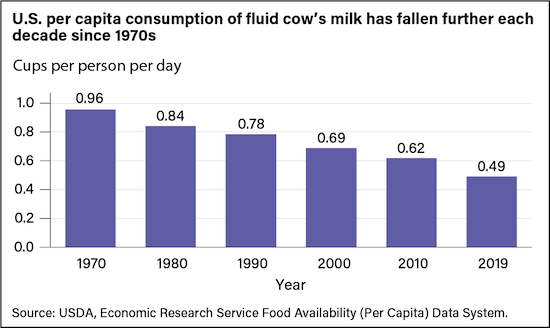
While dairy product sales have steadily grown over the past several decades, fluid milk consumption has dropped repeatedly. From 2010 to 2019, that decline was its most severe according to USDA’s Economic Research Service. Americans went from consuming 0.62 cups of milk per day in 2010 to 0.49 cups of milk per day in 2019.

During a recent Dairy Podcast Show, Iowa State’s Stephanie Clark opined that this steady reduction in fluid milk consumption may breed a generation of lactose intolerant kids.
“If we don’t drink milk, we don’t have to use our native enzyme system to break down the lactose and use it as a nutrient. Then, we can potentially lose the ability,” she explained. “By having so many plant-based alternatives and even promoting our lactose-free milk products to people who don’t necessarily need lactose-free milk products, we may be promoting or developing a lactose intolerant generation down the line.”
Clark conducts research on consumer preferences related to dairy products and anecdotally can tell many stories of people who misperceive maldigestion with intolerance.
“People don’t always recognize the differences and think that any discomfort at all is lactose intolerance,” Clark detailed.
Importantly, she shared, that lactose intolerance and maldigestion are different, with maldigestion being much more common. “It’s actually relatively rare to be completely lactose intolerant, but the terminology is used so freely that it leads to propagating the myth,” she specified.
According to Clark, the symptoms of lactose intolerance or maldigestion occur when the body loses its ability to break apart and utilize lactose as a nutrient. That lactose travels down the digestive tract to the lower gut where natural bacteria there digest the compound, creating gas and the most common lactose maldigestion symptom – bloating.
Different than an allergy
While on the topic of reasons people don’t consume as much fluid milk, Clark also denoted the difference between lactose maldigestion and a milk allergy. Often milk allergies show different symptoms such as hives, fevers, or other immune responses. This is often caused by an allergy to a milk protein rather than lactose.
For consumers shopping for fluid milk, there are several options provided by the dairy industry to address both fluid milk maladies. A2-A2 milk products seem to be easier for those with milk allergies to digest.
For those with lactose maldigestion, there are several lactose-free or reduced lactose options in the dairy aisle these days. That being said, Clark would recommend those with maldigestion and not intolerance continue to drink milk when possible.







